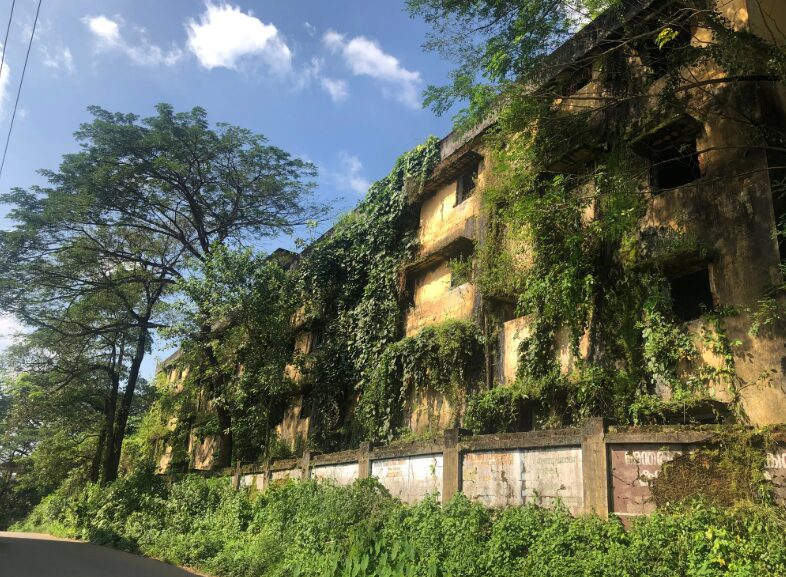Mavoor, a small town near Kozhikode in Kerala, carries a history unlike any other in the region a story inextricably linked to the rise and fall of one colossal industrial venture: Gwalior Rayons (later Grasim Industries). This is the tale of a factory that once promised prosperity but ultimately left behind a complex legacy of environmental damage, social upheaval, and silent ruins.
The Dawn of Industrial Hope
The story begins in the late 1950s, when the then-Communist government of Kerala invited the Birla Group to set up a pulp and fibre factory. Mavoor, an agrarian village nestled on the banks of the Chaliyar River, was chosen as the site. The factory, Gwalior Rayons Silk Mfg. (Wvg.) Co. Ltd., was heralded as a symbol of industrial progress, a significant private sector investment, and a beacon of employment for thousands.
The Boon: Operations began in the early 1960s, turning Mavoor into a bustling industrial township, complete with staff quarters, schools, and a police station. It gave life and livelihood to an estimated 3,000 workers directly, and many more indirectly.
The Price: To attract the industry, the Kerala government provided the company with vast tracts of land and an extremely cheap, long-term supply of raw materials primarily bamboo from the state’s rich forest reserves. This preferential treatment, however, set the stage for future conflicts.
The Turning Tide: Pollution and Protest
The initial goodwill quickly eroded as the factory’s full environmental cost became apparent. The industrial process, which produced rayon-grade pulp and staple fibre, generated highly toxic effluents.
The Poisoned River: The untreated or poorly treated discharge was released directly into the Chaliyar River. The once-pristine river turned black, became foul-smelling, and often hot. Fish died in large numbers, and the water was rendered unfit for bathing, drinking, and agricultural use. This catastrophic pollution directly impacted the livelihoods of thousands of people downstream who depended on the river for fishing, shell-picking, and farming.
The Polluted Air: In addition to water contamination, the factory was accused of severe air pollution, releasing toxic gases like carbon disulphide and sulphur dioxide. Local reports linked the pollution to a rise in diseases, including respiratory illnesses, skin problems, and tragically, higher rates of cancer in the surrounding communities.
The Environmental Movement: The crisis gave birth to what many consider to be Kerala’s first major environmental movement. Local residents, led by activist groups like the Chaliyar Defence Committee, launched sustained, decades-long agitations demanding a non-polluting operation.
Workers vs. Environment
The struggle in Mavoor was complex, often pitting the environmental concerns of the community against the livelihood concerns of the factory workers. Trade unions, fearing the closure of the factory and massive job loss, often took an antagonistic stand against the anti-pollution agitators.
Closure and Reopening: The factory faced lockouts, notably a three-year closure from 1985 to 1988, which devastated the local economy and reportedly led to multiple worker suicides. When it reopened, the trade-off livelihood for a poisoned environment seemed to continue.
The Final Silence
The pressure of environmental protests, coupled with increasing difficulties in securing the promised quantity and quality of raw materials from the government, led to the eventual downfall of the factory.
Permanent Shut-down: Gwalior Rayons (Grasim Industries) formally shut down its pulp plant in 2001.
The Aftermath: The closure brought environmental relief as the Chaliyar River began its slow process of recovery. However, it also delivered a severe economic blow to Mavoor. The vibrant industrial town faded, leaving thousands jobless and the local economy in tatters. Mavoor transformed from a bustling commercial hub into a place often referred to by journalists as “Malabar’s forgotten industrial town,” a place clinging to memories of a prosperous past.
The Unresolved Question of the Land
Today, the 300-plus acres of prime land where the mammoth factory once stood remain largely unused, the site slowly being reclaimed by nature. This massive, vacant industrial park is now the focus of a new agitation.
The local community and panchayat bodies are pressing the government and the Birla Group to either utilize the land for new, eco-friendly industries that can regenerate employment, or return the land much of which was originally acquired by the government from local residents so that the public can pursue new, sustainable development projects. The ruins of Gwalior Rayons stand as a potent, silent reminder of a critical lesson in industrial development: that progress at the expense of the environment and community is ultimately unsustainable.

